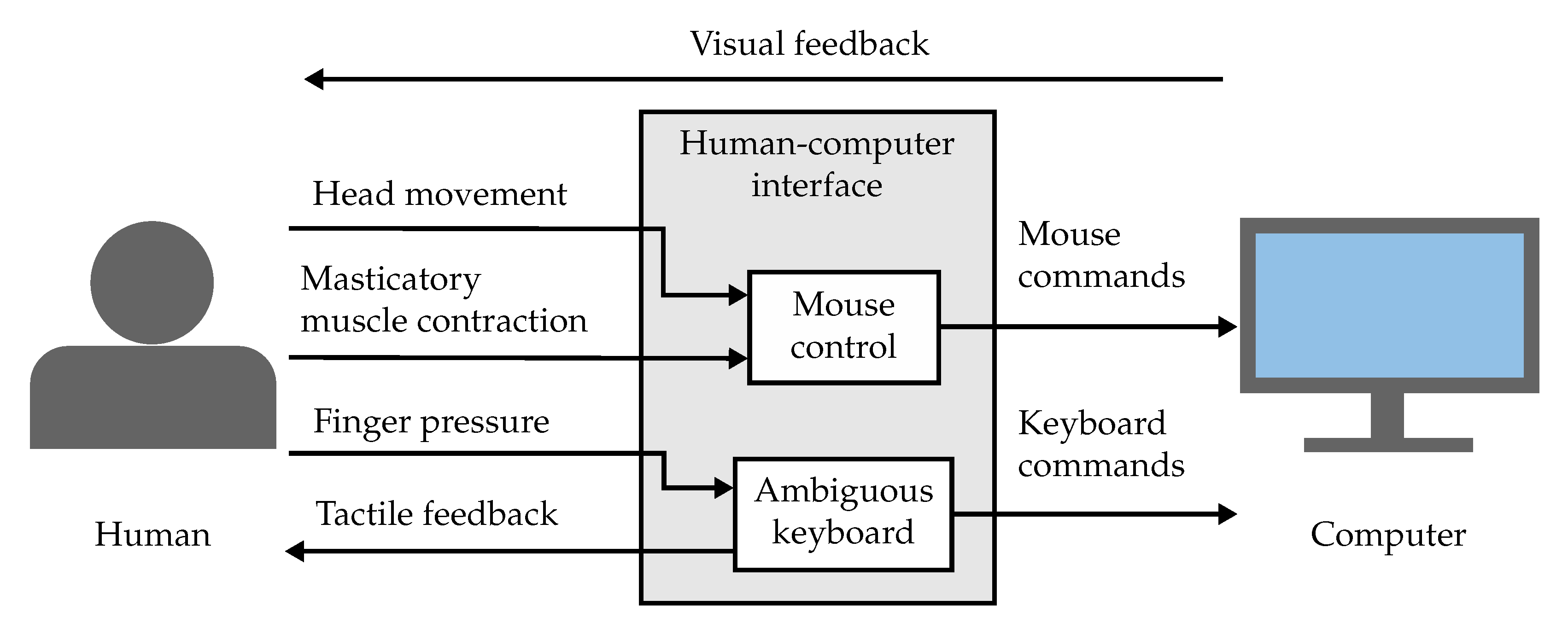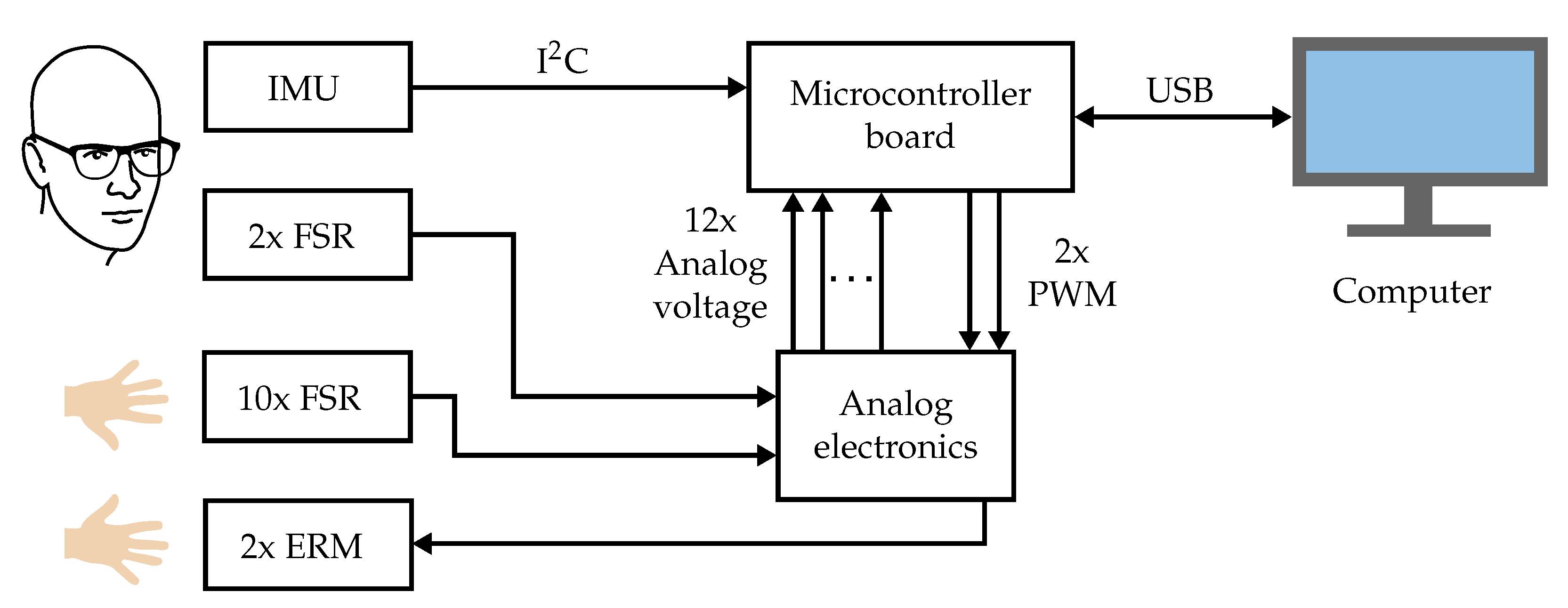A Human–Computer Interface Replacing Mouse and Keyboard for Individuals with Limited Upper Limb Mobility
Abstract
:1. Introduction
2. Interface Concept
2.1. Keyboard Concept
2.2. Mouse Concept
3. Sensors and Feedback
3.1. Sensors
3.2. Feedback
3.3. System Integration
4. Interface Software
4.1. Data Acquisition and Preprocessing
4.2. Computer Input and User Feedback Generation
5. Technical Evaluation
5.1. Mouse Evaluation
5.2. Keyboard Evaluation
6. Discussion
7. Conclusions
Author Contributions
Funding
Conflicts of Interest
References
- Pearson, C.M. Muscular Dystrophy. Am. J. Med. 1963, 35, 632–645. [Google Scholar] [CrossRef]
- Schulz, J.B.; Pandolfo, M. 150 Years of Friedreich Ataxia: From Its Discovery to Therapy. J. Neurochem. 2013, 126 (Suppl. 1), 1–3. [Google Scholar] [CrossRef] [PubMed]
- Lunn, M.R.; Wang, C.H. Spinal Muscular Atrophy. Lancet 2008, 371, 2120–2133. [Google Scholar] [CrossRef]
- Krishnaswamy, K.; Ordó nez, P.; Beckerle, P.; Rinderknecht, S.; Felzer, T. OnScreenDualScribe with Point-and-Click Interface: A Viable Computer Interaction Alternative Based on a Virtual Modified Numerical Keypad. In Proceedings of the 18th International ACM SIGACCESS Conference on Computers and Accessibility, New York, NY, USA, 23–26 October 2016; pp. 257–262. [Google Scholar] [CrossRef]
- Mackenzie, I.S.; Felzer, T. SAK: Scanning Ambiguous Keyboard for Efficient One-Key Text Entry. ACM Trans. Comput.-Hum. Interact. 2010, 17, 1–39. [Google Scholar] [CrossRef]
- Felzer, T.; MacKenzie, I.S.; Beckerle, P.; Rinderknecht, S. Qanti: A Software Tool for Quick Ambiguous Non-Standard Text Input. In Computers Helping People with Special Needs; Lecture Notes in Computer Science; Hutchison, D., Kanade, T., Kittler, J., Kleinberg, J.M., Mattern, F., Mitchell, J.C., Naor, M., Nierstrasz, O., Pandu Rangan, C., Steffen, B., et al., Eds.; Springer: Berlin/Heidelberg, Germany, 2010; Volume 6180, pp. 128–135. [Google Scholar] [CrossRef]
- Miró-Borrás, J.; Bernabeu-Soler, P.; Llinares, R.; Igual, J. Ambiguous Keyboards and Scanning: The Relevance of the Cell Selection Phase. In Human-Computer Interaction—INTERACT 2009; Lecture Notes in Computer Science; Gross, T., Gulliksen, J., Kotzé, P., Oestreicher, L., Palanque, P., Prates, R.O., Winckler, M., Eds.; Springer: Berlin/Heidelberg, Germany, 2009; Volume 5727, pp. 1–4. [Google Scholar] [CrossRef]
- Ghedira, S.; Pino, P.; Bourhis, G. Conception and Experimentation of a Communication Device with Adaptive Scanning. ACM Trans. Access. Comput. 2009, 1, 1–23. [Google Scholar] [CrossRef]
- Li, J.; Deng, L.; Gong, Y.; Haeb-Umbach, R. An Overview of Noise-Robust Automatic Speech Recognition. IEEE/ACM Trans. Audio Speech Lang. Process. 2014, 22, 745–777. [Google Scholar] [CrossRef]
- Yi, Z.; Quan-jie, L.; Yan-hua, L.; Li, Z. Intelligent Wheelchair Multimodal Human-Machine Interfaces in Lip Contour Extraction Based on PMM. In Proceedings of the 2009 IEEE International Conference on Robotics and Biomimetics (ROBIO), Guilin, China, 19–23 December 2009; pp. 2108–2113. [Google Scholar] [CrossRef]
- Young, V.; Mihailidis, A. Difficulties in Automatic Speech Recognition of Dysarthric Speakers and Implications for Speech-Based Applications Used by the Elderly: A Literature Review. Assist. Technol. Off. J. RESNA 2010, 22, 99–112. [Google Scholar] [CrossRef]
- Erol, A.; Bebis, G.; Nicolescu, M.; Boyle, R.D.; Twombly, X. Vision-Based Hand Pose Estimation: A Review. Comput. Vis. Image Underst. 2007, 108, 52–73. [Google Scholar] [CrossRef]
- Poole, A.; Ball, L.J. Eye Tracking in HCI and Usability Research. In Encyclopedia of Human Computer Interaction; Ghaoui, C., Ed.; IGI Global: Hershey, PA, USA, 2006; pp. 211–219. [Google Scholar] [CrossRef]
- Panwar, P.; Sarcar, S.; Samanta, D. EyeBoard: A Fast and Accurate Eye Gaze-Based Text Entry System. In Proceedings of the 2012 4th International Conference on Intelligent Human Computer Interaction (IHCI), Kharagpur, India, 27–29 December 2012; pp. 1–8. [Google Scholar] [CrossRef]
- Tobii Dynavox. PCEye Plus, I-Series Product Page. Available online: https://www.tobiidynavox.com/products/devices/ (accessed on 10 September 2020).
- Eyetech Digital Systems. TM5-Mini by Eyetech Digital Systems Product Page. Available online: https://www.eyetechds.com/tm5mini.html (accessed on 10 September 2020).
- Gibbons, C.; Beneteau, E. Functional Performance Using Eye Control and Single Switch Scanning by People With ALS. Perspect. Augment. Altern. Commun. 2010, 19, 64–69. [Google Scholar] [CrossRef]
- Zadikoff, C.; Lang, A.E. Apraxia in Movement Disorders. Brain A J. Neurol. 2005, 128, 1480–1497. [Google Scholar] [CrossRef] [Green Version]
- Karpov, A.; Cadiou, A. Hands-Free Mouse Control System for Handicapped Operators. In Proceedings of the 11-th International Conference SPECOM, St. Petersburg, Russia, 25–29 June 2006; pp. 525–529. [Google Scholar]
- Loewenich, F.; Maire, F.D. Motion-Tracking and Speech Recognition for Hands-Free Mouse Pointer Manipulation. In Speech Recognition; Mihelic, F., Zibert, J., Eds.; IN-TECH: Rijeka, Croatia, 2008; pp. 427–434. [Google Scholar]
- NaturalPoint. SmartNav by NaturalPoint Product Page. Available online: https://www.naturalpoint.com/smartnav/ (accessed on 10 September 2020).
- Origin Instruments. HeadMouse Nano Product Page. Available online: https://www.orin.com/access/headmouse/ (accessed on 10 September 2020).
- Tsai, P.S.; Wu, T.F.; Hu, N.T.; Chen, J.Y. Assistive Computer Input Device for Muscular Atrophy Patients. Adv. Mech. Eng. 2016, 8, 168781401664910. [Google Scholar] [CrossRef] [Green Version]
- Dalka, P.; Czyzewski, A. Human-Computer Interface Based on Visual Lip Movement and Gesture Recognition. Int. J. Comput. Sci. Appl. 2010, 7, 124–139. [Google Scholar]
- Orhan, U.; Erdogmus, D.; Roark, B.; Purwar, S.; Hild, K.E.; Oken, B.; Nezamfar, H.; Fried-Oken, M. Fusion with Language Models Improves Spelling Accuracy for ERP-Based Brain Computer Interface spellers. In Proceedings of the 2011 Annual International Conference of the IEEE Engineering in Medicine and Biology Society, Boston, MA, USA, 30 August–3 September 2011; Volume 2011, pp. 5774–5777. [Google Scholar] [CrossRef] [Green Version]
- Fabiani, G.E.; McFarland, D.J.; Wolpaw, J.R.; Pfurtscheller, G. Conversion of EEG Activity Into Cursor Movement by a Brain-Computer Interface (BCI). IEEE Trans. Neural Syst. Rehabil. Eng. 2004, 12, 331–338. [Google Scholar] [CrossRef] [PubMed]
- Dhillon, H.S.; Singla, R.; Rekhi, N.S.; Jha, R. EOG and EMG Based Virtual Keyboard: A Brain-Computer Interface. In Proceedings of the 2009 2nd IEEE International Conference on Computer Science and Information Technology, Beijing, China, 8–11 August 2009; pp. 259–262. [Google Scholar] [CrossRef]
- Chin, C.A.; Barreto, A.; Adjouadi, M. Integration of EMG and EGT Modalities for the Development of an Enhanced Cursor Control System. Int. J. Artif. Intell. Tools 2009, 18, 399–414. [Google Scholar] [CrossRef] [Green Version]
- Yamagishi, K.; Hori, J.; Miyakawa, M. Development of EOG-Based Communication System Controlled by Eight-Directional Eye Movements. In Proceedings of the 2007 29th Annual International Conference of the IEEE Engineering in Medicine and Biology Society, New York, NY, USA, 30 August–3 September 2006; Volume 1, pp. 2574–2577. [Google Scholar] [CrossRef]
- Krusienski, D.J.; Sellers, E.W.; McFarland, D.J.; Vaughan, T.M.; Wolpaw, J.R. Toward Enhanced P300 Speller Performance. J. Neurosci. Methods 2008, 167, 15–21. [Google Scholar] [CrossRef] [Green Version]
- Pfurtscheller, G.; Neuper, C.; Guger, C.; Harkam, W.; Ramoser, H.; Schlögl, A.; Obermaier, B.; Pregenzer, M. Current Trends in Graz Brain-Computer Interface (BCI) Research. IEEE Trans. Rehabil. Eng. 2000, 8, 216–219. [Google Scholar] [CrossRef]
- Jose, M.A.; de Deus Lopes, R. Human-Computer Interface Controlled by the Lip. IEEE J. Biomed. Health Inform. 2015, 19, 302–308. [Google Scholar] [CrossRef]
- Bozkurt, F.; Çağdaş Seçkin, A.; Coşkun, A. Integration of IMU Sensor on Low-Cost EEG and Design of Cursor Control System with ANFIS. Int. J. Eng. Trends Technol. 2017, 54, 162–169. [Google Scholar] [CrossRef]
- Felzer, T.; Rinderknecht, S. Text Entry by Raising the Eyebrow with HaMCoS. In Proceedings of the 16th International ACM SIGACCESS Conference on Computers & Accessibility—ASSETS ’14; Kurniawan, S., Richards, J., Eds.; ACM Press: New York, NY, USA, 2014; pp. 355–356. [Google Scholar] [CrossRef]
- Beukelman, D.R.; Fager, S.; Ball, L.; Dietz, A. AAC for Adults with Acquired Neurological Conditions: A Review. Augment. Altern. Commun. 2007, 23, 230–242. [Google Scholar] [CrossRef]
- Esposito, D.; Andreozzi, E.; Fratini, A.; Gargiulo, G.D.; Savino, S.; Niola, V.; Bifulco, P. A Piezoresistive Sensor to Measure Muscle Contraction and Mechanomyography. Sensors 2018, 18, 2553. [Google Scholar] [CrossRef] [Green Version]
- Abrams, A.M.H.; Weber, C.F.; Beckerle, P. Design and Testing of Sensors for Text Entry and Mouse Control for Individuals with Neuromuscular Diseases. In Proceedings of the 20th International ACM SIGACCESS Conference on Computers and Accessibility; Hwang, F., McGrenere, J., Flatla, D., Eds.; ACM: New York, NY, USA, 2018; pp. 398–400. [Google Scholar] [CrossRef]
- Molina Cantero, A.J.; Rivera Romero, O.; Gómez González, I.M.; Merino Monge, M.; Ropero Rodríguez, J. Comparison Among Ambiguous Virtual Keyboards for People with Severe Motor Disabilities. IJMER Int. J. Mod. Eng. Res. 2011, 1, 288–305. [Google Scholar]
- Pacchierotti, C.; Sinclair, S.; Solazzi, M.; Frisoli, A.; Hayward, V.; Prattichizzo, D. Wearable Haptic Systems for the Fingertip and the Hand: Taxonomy, Review, and Perspectives. IEEE Trans. Haptics 2017, 10, 580–600. [Google Scholar] [CrossRef] [PubMed] [Green Version]
- Barrett, K.E.; Barman, S.M.; Boitano, S.; Brooks, H.L. Ganong’s Review of Medical Physiology, 25th ed.; McGraw-Hill Education: New York, NY, USA, 2016. [Google Scholar]
- Mackenzie, I.S.; Soukoreff, R.W. Phrase Sets for Evaluating Text Entry Techniques. In CHI ’03 Extended Abstracts on Human Factors in Computing Systems—CHI ’03; Cockton, G., Korhonen, P., Eds.; ACM Press: New York, NY, USA, 2003; p. 754. [Google Scholar] [CrossRef] [Green Version]
- Mackenzie, I.S. KSPC (Keystrokes per Character) as a Characteristic of Text Entry Techniques. In Human Computer Interaction with Mobile Devices; Paternò, F., Ed.; Springer: Berlin/Heidelberg, Germany, 2002; pp. 195–210. [Google Scholar]
- Stassi, S.; Cauda, V.; Canavese, G.; Pirri, C.F. Flexible Tactile Sensing Based on Piezoresistive Composites: A Review. Sensors 2014, 14, 5296–5332. [Google Scholar] [CrossRef] [PubMed] [Green Version]
- Hollinger, A.; Wanderley, M.M. Evaluation of Commercial Force Sensing Resistors. In Proceedings of the International Conference on New Interfaces for Musical Expression, Paris, France, 4–8 June 2006; pp. 4–8. [Google Scholar]
- Venkatagiri, H. Efficient Keyboard Layouts for Sequential Access in Augmentative and Alternative Communication. Augment. Altern. Commun. 1999, 15, 126–134. [Google Scholar] [CrossRef]












| my bank account is overdrawn |
| we are having spaghetti |
| my favorite subject is psychology |
| great disturbance in the force |
| a steep learning curve in riding a unicycle |
Publisher’s Note: MDPI stays neutral with regard to jurisdictional claims in published maps and institutional affiliations. |
© 2020 by the authors. Licensee MDPI, Basel, Switzerland. This article is an open access article distributed under the terms and conditions of the Creative Commons Attribution (CC BY) license (http://creativecommons.org/licenses/by/4.0/).
Share and Cite
Gür, D.; Schäfer, N.; Kupnik, M.; Beckerle, P. A Human–Computer Interface Replacing Mouse and Keyboard for Individuals with Limited Upper Limb Mobility. Multimodal Technol. Interact. 2020, 4, 84. https://doi.org/10.3390/mti4040084
Gür D, Schäfer N, Kupnik M, Beckerle P. A Human–Computer Interface Replacing Mouse and Keyboard for Individuals with Limited Upper Limb Mobility. Multimodal Technologies and Interaction. 2020; 4(4):84. https://doi.org/10.3390/mti4040084
Chicago/Turabian StyleGür, Diyar, Niklas Schäfer, Mario Kupnik, and Philipp Beckerle. 2020. "A Human–Computer Interface Replacing Mouse and Keyboard for Individuals with Limited Upper Limb Mobility" Multimodal Technologies and Interaction 4, no. 4: 84. https://doi.org/10.3390/mti4040084
APA StyleGür, D., Schäfer, N., Kupnik, M., & Beckerle, P. (2020). A Human–Computer Interface Replacing Mouse and Keyboard for Individuals with Limited Upper Limb Mobility. Multimodal Technologies and Interaction, 4(4), 84. https://doi.org/10.3390/mti4040084





